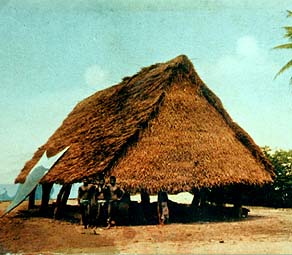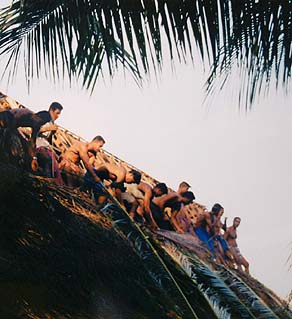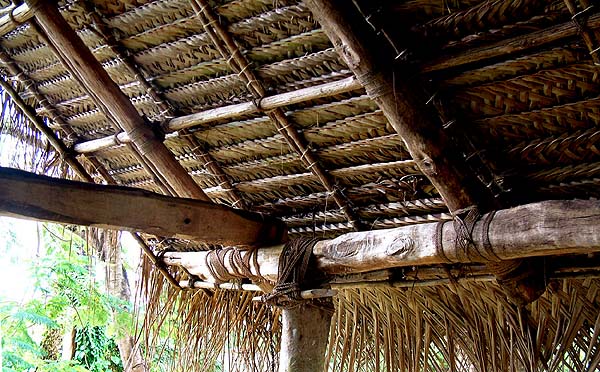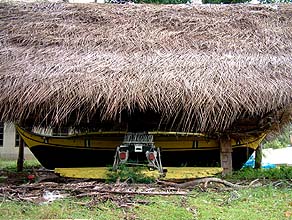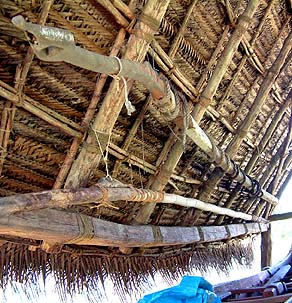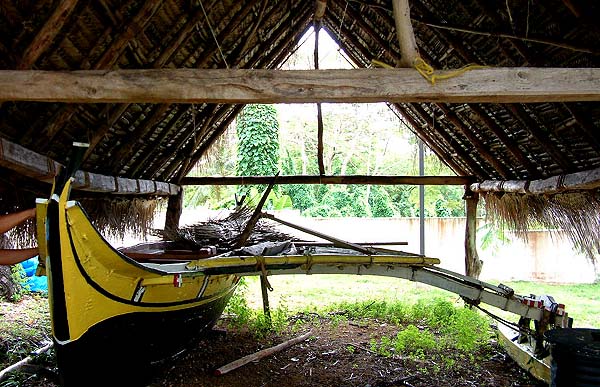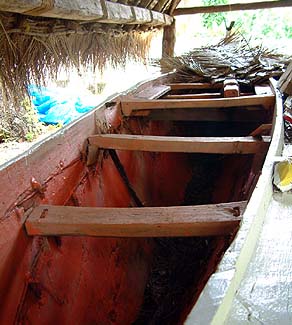 |
 |
 |
|||||
|
|
|
|
|
|
|
|
|
|
|
|||||||
|
|
|
|
|
|
“Here in Tanapag we traditionally have an utt, or Carolinian canoe shed, called the Talaabwogh Falawel,” Ben says. Talaabwogh is the Carolinian name for Tanapag, and Falawel is the name of this specific house, in Tanapag. “The utt serves as a Carolinian meeting hall. Other villages don’t have this utt in the village.”
|
||
|
|
||
“During the Japanese times, there were two utt. There, we repair canoes, we meet with the men, talk about and prepare for fishing activities, prepare for cultural events, or have Carolinian Stick Dances. That is one of the most popular traditions here on Saipan. Those are performed by the boys here in Tanapag. “The utt is the men’s house. This is where the men get together and meet, discuss certain things, certain issues about the village. If somebody got drunk the other day, we need to talk to the families of these people who are disruptive. Sometimes the Chief will say ‘no more coconut toddy’—making tuba and fermenting it and getting drunk. He’ll make certain restrictions according to certain behaviors in the village."
|
|
|
“It’s very important that we learn about the utt,” Dave states. “That’s a meeting place where people have to put their attention more closely to the chief. The chief organizes what is to be done, he’s a decision-maker. For instance, going fishing, they would all go in a group, and when they came back, they would have to meet with the chief again and determine how to split up whatever fish they caught. “Long time ago, we had to share the fish. All the catch of the day we had to share it among the families, the relatives. We expect them to give us the fish, even those who don’t go fishing. They have to give the share to people in the community.” “Utt is also a place where we organize events like the fiesta. If we have a fiesta, we have to get over to the utt and help one another—preparing food, preparing canoes and preparing other part of things that we need to utilize for the fiesta.”
|
|
|
|
The utt is constructed with wood, rope, and coconut thatching.
|
“I think this is the usual size and dimensions,” Noel explains, discussing the utt contracted by the CNMI Museum to house a traditional canoe. “Maybe about twenty feet by forty feet. Traditionally the rope would be made out of coconut husk. Sometimes the men would add a wood platform straight up on the rafters, giving them another story where they can sleep. "The men would usually work down below, and they would teach all the boys how to do carving, how to make the rope, what to prepare, what kind of wood to use for the canoe, and all the story-telling and other traditions. Women are not really actually permitted in there."
|
||
|
|
||
“The only taboo,” Rosa Castro says, “is when the men are in the men’s house, we women have to bypass the men’s house to go into the ocean. For us who are not of age yet…I’m not going to hide. I’m going to say it the clear way: the women who have their period, it’s taboo to go down that way. "The older women, if they have a cousin, the elder women who have cousins down there, they have to bow down, practically walking on their legs at a low profile, crouched very low because they respect the men."
|
. |
|
“Nowadays we allow women to go in there,” Ben says, “because we don’t wear thu’s (loinclothes) anymore. Those are gone. On my first trip on a sailing canoe from Satawal, women were not allowed, because we had guests from Satawal and from the island of Puluwat. There were six canoes in the year 2000, and all the men were in thu’s, so women were not allowed inside the utt. "But for village purposes, women are now allowed to go in there for meetings. But if only men are going to meet, women are asked to stay outside until we’re done. But otherwise it’s allowable now. Times have changed, I guess."
|
|
|
|
Canoe in the CNMI Museum utt.
|
“This canoe came from the Carolinian islands,” Noel explains, “and they sailed it from the central Carolines, all the way up north to the Marianas in 1976. The Carolinians still practice their traditional navigation, including canoe-making and everything. This is an old canoe, made out of breadfruit wood. A lot of them are ninety-percent breadfruit.”
|
||
|
|
||
“You can see how it is carved inside, and the rope, how they sew it together. There are maybe two or three other canoes on Saipan, in Garapan. And there are some smaller paddling canoes of the same design. As far as Chamorro canoes, there are none in here. I hope I’ll be the first one to build one, myself. “When they put in the canoe, they put down the mast, so it’s easier to put it in. The utt will protect the canoe from the sun. The minute a canoe comes to the shore, they have to remove it away from the water because in the ocean, there is a worm that will eat holes inside the wood."
|
|
|
|
|
| "We needed to pull down our utt," Ben says, "The coconut fronds that we used were just rotting away, and it became very leaky during the rainy season. We were not able to use it because of the leaks. And we noticed that the wood had been eaten. There’s a boring insect, and the structure had become so weakened that we were afraid that it might collapse on some of the children that were playing there. We still have all the foundations there. It isn’t concrete. It is still sandy ground. But we will be renovating our utt here in the village”
|
||
|
|
||
|
|
|
|
|
|

|
| Tanapag Home | Map Library | Site Map | Pacific Worlds Home |
|
|
|
|

|
|
|
|||
| Copyright 2003 Pacific Worlds & Associates • Usage Policy • Webmaster |
|||

